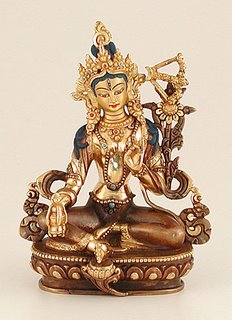
The picture above depicts a statue of Red Tara, which I recently purchased for my shrine. I chose her because, one the one hand, I felt like some gender balance was needed, on the other hand the Khenpos suggested Tara as a good statue for our new shrines, and on the gripping hand, we perform a Red Tara sadhana at our center twice a month. Okay, I better explain what's going on in that last sentence. There's at least two science fiction novels by Larry Niven and Jerry(?) Pournelle in which an alien race with three hands exists. They have a modified phrase for "On the other hand," since they have two other hands, which allows them to make three points. For some reason, the third hand is called the "gripping hand." Hee hee. Some forms of Avalokiteshvara (Chenrezi) have one thousand hands, which could be extremely convenient for setting forth multiple contingencies.
Red Tara practice is, to my mind, somewhat complicated. I haven't received transmission of the teaching, so perhaps that's why. If the chance ever comes, I will definitely take it. In any event, I've been listening to a CD, which helps. Red Tara is said to be the embodiment of pure awareness. So praying to Tara, and performing a Red Tara sadhana, are ways to awaken our own perception of pure phenomena, of reality in its actuality. To see that nothing exists independently.
There are two beautiful mantras that are chanted in the sadhana. I wish that I could convey their tune, but I'll have to content myself to simply reproducing the english transliteration of the syllables.
Mantra 1: JE TZUN P'HAG MA DROL MA KHYED KHYEN NO GAL KYEN KUN SEL SAM DON NYUR DRUB DZOD
Mantra 2: OM TARE TAM SOHA
When chanting mantras I try to think of myself as a vibrating bell, releasing energy as I vocalize the syllables. It is especially potent when done with others.
No comments:
Post a Comment